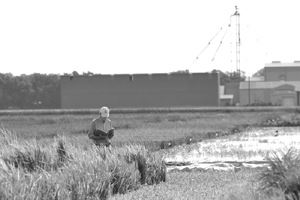|
Progress Continues On Hybrid Rice Breeding
CROWLEY, LA.
Hybrid development at the Rice Research Station continues to make progress under hybrid rice breeders Jim Oard and Weike Li.
Oard, an LSU AgCenter researcher and professor, said a preliminary yield trial resulted in 16 of 35 hybrid lines having a 15-20 percent yield advantage over conventional varieties CL152 and Catahoula, and nine had yields exceeding commercial hybrids CLX729 and XL723.
Multilocation trials of eight new hybrids were conducted in Acadia, St. Landry and Vermilion parishes in 2014, Oard said. Results showed good yield and milling quality.
Four hybrids from the LSU AgCenter were tested by the University of Arkansas, he said. “There were 30 entries, and the best ones were the Louisiana hybrids.”
The fact that the hybrids performed well in Arkansas demonstrates their adaptability to different locations, Oard said.
Hybrids are evaluated not only for yield but also for milling quality. Oard said the new cereal chemistry lab run by Ida Wenefrida, researcher and assistant professor at the Rice Station, enables quick results for testing amylose content and gelatinization temperature. “Otherwise, we’d be waiting for months to get these grain quality results,” he said.
Chalk is a major quality consideration. “It’s a big issue we are paying a lot of attention to,” he said. Grain uniformity also is emphasized in the program.
Oard said 1,200 crosses made in 2014 resulted in 12 lines with yield advantages over commercial hybrid CLXL729. Many of those new lines have the Clearfield trait.
The hybrid program is also incorporating the new Provisia herbicide resistance trait. “We think it will be a good complement to the Clearfield technology,” he said.

Jim Oard, LSU AgCenter hybrid rice breeder, looks over his notes while
inspecting hybrid plots at the Rice Research Station.
Photo by Bruce Schultz
Even though the hybrid program has been underway for four years at the Rice Station, work continues on fine-tuning the process. Oard said the seed production system is being improved with the use of seed treatments to make sure male-sterile and fertile pollinator plants flower simultaneously.
The program is close to having a commercially viable hybrid. “I would say within two to three years we’ll have a rice hybrid that will be of commercial interest,” he said.
Li, a research associate at the station, also is optimistic. He said the hybrid program is progressing well, and several lines show promise with good milling quality, short stature and excellent yields. “I can say I’m quite sure we will be successful.”
The research on hybrids is supported by funds provided through the rice checkoff program. “This program has paid excellent dividends for 40 plus years and will continue to help the rice industry in the future,” said Steve Linscombe, director of the Rice Research Station and the AgCenter’s Southwest Region. ∆
|
|